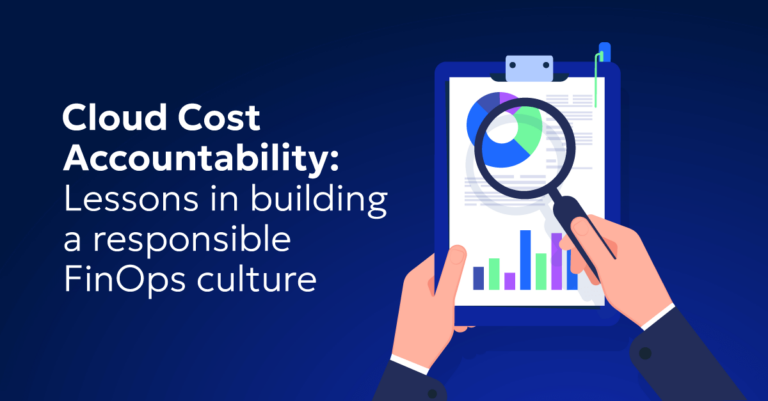
Cloud Cost Accountability: Lessons in Building a Responsible FinOps Culture
As a FinOps professional who has struggled with how to build cloud cost accountability in organizations for over a decade, I understand the challenges that come with managing cloud budgets. For many of us, the end of each month brings a sense of dread as we face yet another battle with unpredictable cloud expenses.
Without clear ownership and visibility, costs can quickly spiral out of control. Establishing cloud accountability is crucial not only for keeping budgets in check but also for ensuring that resources are used efficiently and responsibly. It fosters a culture of transparency and responsibility, leading to better financial decisions and sustainable cloud usage. Through my experience and work as a consultant for various clients, I’ve developed a methodology to establish cloud accountability that can help bring your cloud costs under control even in complex environments:
1. Establish Clear Ownership
One of the first steps in building cloud cost accountability is to establish clear ownership of resources. Without defined ownership, it’s easy for costs to spiral out of control as no one takes responsibility for managing and optimizing cloud usage.
- Assign Resource Owners: Designate specific individuals or teams to be responsible for each resource or set of resources. This ensures accountability and makes it easier to track and optimize usage.
- Use Tagging: Implement a consistent tagging strategy to label resources with the owner’s name, department, and purpose. This not only helps in tracking but also in reporting and cost allocation.
2. Implement Detailed Cost Allocation
To truly understand and control cloud spending, you need to know where every dollar is going. Implementing detailed cost allocation practices is crucial for achieving this level of insight.
- Cost Centers: Set up cost centers for different departments or projects. This allows you to allocate costs accurately and identify which areas are driving expenses.
- Chargeback and Showback: Use chargeback or showback models to provide visibility into cloud spending. Chargeback involves billing departments for their usage, while showback provides usage reports without actual billing. Both methods foster accountability and encourage responsible spending.
3. Adopt Cost Management Tools
Modern cloud platforms offer a range of tools designed to help manage and optimize costs. Leveraging these tools can make a significant difference in maintaining cloud cost accountability.
- AWS Cost Explorer and Azure Cost Management: These tools provide detailed insights into your spending patterns, helping you identify trends, anomalies, and areas for optimization.
- Automated Budget Alerts: Set up automated alerts to notify you when spending approaches or exceeds budget thresholds. This proactive approach allows you to take corrective actions before costs get out of hand.
4. Regular Audits and Reviews
Routine audits and reviews are essential for maintaining cloud cost accountability. These practices ensure that your cost management strategies remain effective and that any issues are addressed promptly.
- Monthly Audits: Conduct monthly audits to review resource usage, spending patterns, and compliance with your cost management policies. This helps in identifying any discrepancies or inefficiencies.
- Performance Reviews: Regularly review the performance of your cost management strategies. This involves assessing whether your budgeting, monitoring, and optimization efforts are yielding the desired results.
5. Foster a Culture of Accountability
Building cloud cost accountability is not just about tools and processes; it’s also about fostering a culture of accountability within your organization. This can be challenging, especially if you’re not naturally assertive, but there are strategies to help.
- Training and Awareness: Provide training to your teams on the importance of cloud cost management and how they can contribute to it. Awareness campaigns can help reinforce the significance of responsible cloud usage.
- Incentivize Savings: Consider implementing incentive programs that reward teams or individuals for achieving cost savings. This not only motivates them to be more mindful of their usage but also encourages continuous improvement.
- Regular Communication: Establish regular communication channels to discuss cloud costs. Set up weekly or bi-weekly meetings to review expenses, discuss any issues, and brainstorm solutions. Use these meetings to highlight successes and areas for improvement.
- Use Dashboards and Reports: Create and share dashboards and reports that clearly show each team’s spending. Visual tools can make it easier for everyone to understand and track their costs.
- Follow-Up Actions: Ensure there are clear follow-up actions from each meeting. Assign tasks and deadlines to address any identified issues or optimization opportunities.
6. Leverage Automation
Automation can be a powerful ally in maintaining cloud cost accountability. By automating repetitive tasks, you can reduce the risk of human error and ensure consistent application of your cost management policies.
- Auto-Scheduling: Use automatic scheduling to automatically shut down non-essential resources during off-hours. This simple practice can lead to significant savings over time.
- Automated Scaling: Implement automated scaling to adjust resource allocation based on actual demand. This ensures that you are not over-provisioning and paying for unused capacity.
7. Continuous Improvement
Finally, remember that building cloud cost accountability is an ongoing process. Continuously seek ways to improve your strategies and adapt to changing circumstances.
- Feedback Loop: Establish a feedback loop with your teams to gather insights and suggestions for improving cost management practices. This collaborative approach can lead to innovative solutions and better results.
- Stay Updated: Keep abreast of the latest trends and best practices in cloud cost management. Attend industry conferences, webinars, and training sessions to stay informed and enhance your skills.
Case Study: Transforming Cloud Cost Accountability at a Global Health Tech Company
I want to share an interesting story about a global health tech company I worked with a few years ago. They were struggling with ballooning cloud costs and a lack of accountability. Their challenges were all too familiar: unpredictable monthly expenses, no clear ownership of resources, and a fragmented approach to cost management. The global spread of their offices added an extra layer of complexity to managing cloud costs effectively.
The Ownership Problem
When I started working with this company, it was clear that no one felt accountable for the cloud resources they were using. We first tackled this by establishing clear ownership of resources. Specific teams were designated responsible for their cloud usage, which immediately brought a sense of accountability and ownership.
Lack of Visibility and Cost Allocation
Next, we addressed the lack of visibility into spending. By setting up cost centers and using a chargeback model, we provided transparency into each department’s spending. This change fostered a culture of responsibility, as teams could now see the direct impact of their cloud usage on the overall budget.
Tools and Proactive Management
We then introduced cost management tools like AWS Cost Explorer, which provided detailed insights into their spending patterns. Automated budget alerts were set up to notify teams when they approached budget thresholds, allowing for proactive management and preventing surprise expenses at the end of the month.
Routine Checks and Balance
To ensure ongoing accountability, regular audits and reviews were instituted. Monthly audits helped identify discrepancies or inefficiencies, while performance reviews ensured that cost management strategies were effective and yielding the desired results.
Building a Culture of Accountability
To truly foster a culture of accountability, we provided training and raised awareness about the importance of cloud cost management. Regular meetings were established to discuss expenses, review reports, and address issues. Given their global presence, virtual dashboards and reports were implemented so all teams could access and understand their spending, ensuring transparency and communication across all locations.
Automation for Efficiency
Automation played a crucial role in their success. By implementing auto-scheduling and automated scaling, we ensured that resources were used efficiently, leading to significant savings over time.
Results and Transformation
The transformation was remarkable. Within six months, the company saw a significant reduction in cloud costs, improved budget predictability, and a more accountable organizational culture. Teams became more proactive in managing their resources, leading to sustainable cloud usage and financial stability.
By following these steps and incorporating these practices into your daily operations, you can build a robust framework for cloud cost accountability. From my own experience, I know that the journey isn’t easy, but with dedication and the right strategies, you can achieve a sustainable and transparent cloud environment. The goal is not just to reduce costs but to support your organization’s objectives and ensure long-term success.









